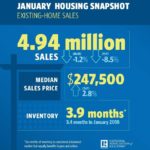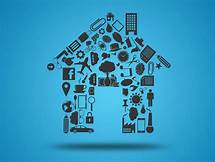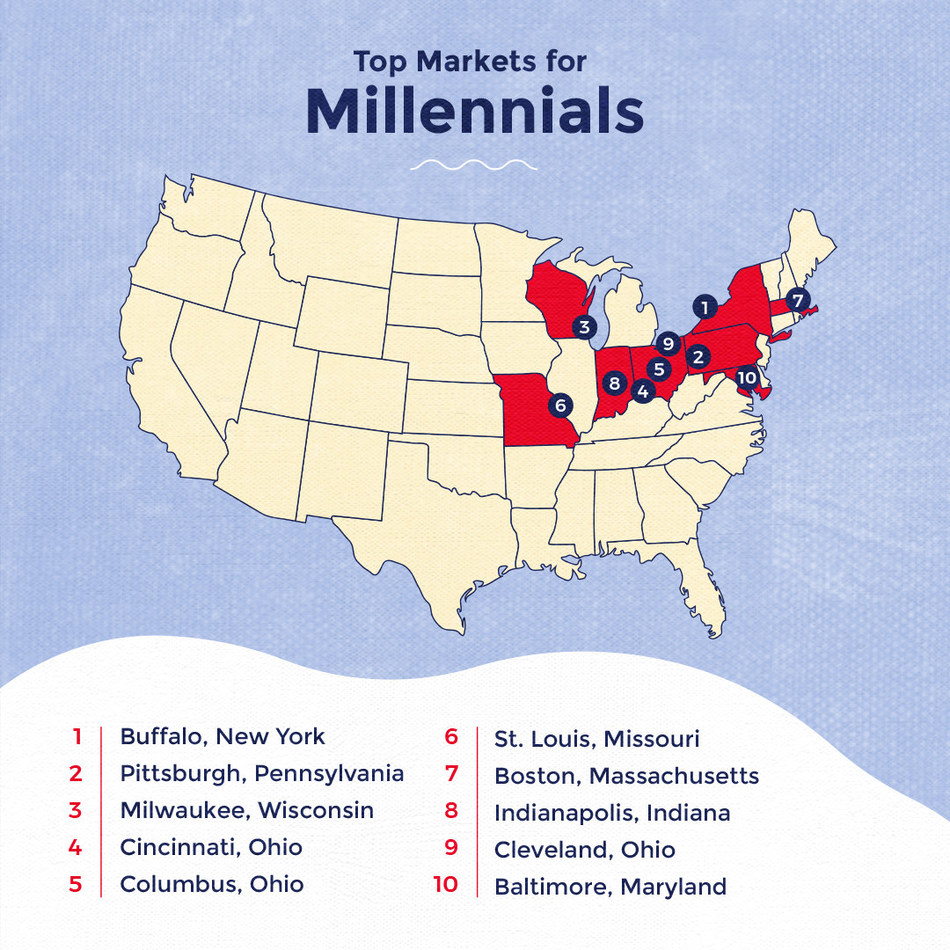TRENDING WHITEPAPERS,VIDEOS & MORE

matt
Existing Home Sales Weak in January, But Have 'Likely' Reached a Low
- Thursday, 21 February 2019

The sale of existing homes fell to a seasonally adjusted annual rate of 4.94 million, or 1.2 percent, in January compared with December.
[caption id="attachment_10266" align="alignleft" width="320"] January 2019 Housing Snapshot[/caption]
January 2019 Housing Snapshot[/caption]
Sales are now down from an annual rate of 5.4 million, or 8.5 percent, compared with the same period in 2018 year ago, according to National Association of Realtors. Of the four major U.S. regions, only the Northeast saw an uptick in sales activity last month.
"Existing home sales in January were weak compared to historical norms; however, they are likely to have reached a cyclical low,” said Lawrence Yun, NAR's chief economist “Moderating home prices combined with gains in household income will boost housing affordability, bringing more buyers to the market in the coming months." Although last month’s home sales were the lowest since November 2015, he doesn’t expect the numbers to decline further going forward.
The median existing-home price for all housing types in January was $247,500, up 2.8 percent from January 2018 ($240,800). January's price increase marks the 83rd straight month of year-over-year gains.
[adbutler zone_id="326324"]
[adbutler zone_id="326327"]
The median home price growth is the slowest since February 2012, and he is cautious the figures don’t tell the full story for the month of January. "Lower mortgage rates from December 2018 had little impact on January sales; however, the lower rates will inevitably lead to more home sales."
Total housing inventory, at the end of January increased to 1.59 million, up from 1.53 million existing homes available for sale in December, an increase from 1.52 million a year ago. Unsold inventory is 3.9-month supply at the current sales pace, up from 3.7 months in December and from 3.4 months in January 2018.
Properties remained on the market for an average of 49 days in January, up from 46 days in December and 42 days a year ago. Thirty-eight percent of homes sold in January were on the market for less than a month.
While inventory grew (on a year-over-year basis) for the sixth straight month, Yun thinks the market is still suffering from an inventory shortage. "In particular, the lower end of the market is experiencing a greater shortage, and more home construction is needed," says Yun. "Taking steps to lower construction costs would be a tremendous help. Local zoning ordinances should also be reformed, while the housing permitting process must be expedited; these simple acts would immediately increase homeownership opportunities and boost local economies."
First-time buyers were responsible for 29 percent of sales in January, down from last month (32 percent), but the same as a year ago. All-cash sales accounted for 23 percent of transactions in January, up from December and a year ago (22 percent in both cases). Individual investors, who account for many cash sales, purchased 16 percent of homes in January, up from 15 percent in December, but down from a year ago (17 percent).
Distressed sales--foreclosures and short sales--represented 4 percent of sales in January, up from 2 percent last month and down from 5 percent a year ago. One percent of January sales were short sales.
Single-family home sales sit at a seasonally adjusted annual rate of 4.37 million in January, down from 4.45 million in December and 8.4 percent below the 4.77 million sales pace from a year ago. The median existing single-family home price was $249,400 in January, up 3.1 percent from January 2018.
Existing condominium and co-op sales were recorded at a seasonally adjusted annual rate of 570,000 units in January, up 3.6 percent from last month and down 9.5 percent from a year ago. The median existing condo price was $233,000 in January, which is up 0.1 percent from a year ago.
January existing-home sales in the Northeast increased 2.9 percent to an annual rate of 700,000, 1.4 percent below a year ago. The median price in the Northeast was $270,000, which is up 0.4 percent from January 2018.
In the Midwest, existing-home sales fell 2.5 percent from last month to an annual rate of 1.16 million in January, down 7.9 percent overall from a year ago. The median price in the Midwest was $189,700, which is up 1.4 percent from last year.
Existing-home sales in the South dropped 1.0 percent to an annual rate of 2.08 million in January, down 8.4 percent from last year. The median price in the South was $214,800, up 2.5 percent from a year ago.
Existing-home sales in the West dipped 2.9 percent to an annual rate of 1.00 million in January, 13.8 percent below a year ago. The median price in the West was $374,600, up 2.9 percent from January 2018.
Read more...loanDepot Technology Brings 8-Day Closings (Possibly)
- Wednesday, 20 February 2019

The mello smartloan is envisioned as an end-to-end digital mortgage that’s designed for online consumers, reducing the stress and frustration that can accompany that process.
To attain that goal, mello smartloan loan origination system was combined with intelligent data sources to create a 'smartloan’ that holds the promise of reducing by up to 80 percent the time required close a loan. Also, it many cases it will eliminate the cost and time appraisals require--enabling loan officers to deliver results in minutes, at no obligation.
The mello smartloan is built upon the concepts of value, speed and transparency. Now, loanDepot customers can, within as little as seven minutes, know their loan will move forward because their data can be digitally validated within seconds. Faster, smoother, more certain closings translate into real benefit for loanDepot customers, especially in aggressive housing markets, or when seeking the tangible economic benefits refinances can offer.
| [adbutler zone_id="326324"] |
The mello smartloan was designed to provide access to technology and experienced advisors to customers—all with an eye to significant time-and cost savings.
Borrowers can gain convenience as well as full-digital documentation capabilities; for loan officers, the data derived from loanDepot's proprietary loan engines enables them to feel confident when working with borrowers. The platform can determine if borrowers have the potential to close their mortgages in as soon as eight days from the date of application.
"We designed the mello smartloan to mirror the digital experience that today's consumer wants," said Anthony Hsieh, founder and CEO of loanDepot. "The mello smartloan leapfrogs decades of traditional industry reliance on paper documentation and physical files. Our technology accelerates beyond current front-end data validation techniques to eliminate homebuyers' biggest stressors: Voluminous documentation requirements and extended loan processing and cycle times. The mello smartloan eliminates the paperwork and the guesswork, while delivering a great product at a great value."
loanDepot has invested more than $80 million in the proprietary technology that powers the mello smartloan, according to the company. Up to 55 percent of loan applicants are eligible for the program, and some might attain better loan pricing because of lower overhead costs.
Read more...Rise of Millennial Home Buyers
- Wednesday, 20 February 2019

The millennial generation have increased their home buying purchase power and now boast the largest share of new home loans by dollar volume, larger than Generation X and the baby boomer generation.
Millennials are showing interest in more affordable markets. Additionally, millennials are making lower down payments and taking on larger mortgages when compared to Gen Xers and baby boomers, according to a realtor.com analysis of residential mortgage loan originations from Optimal Blue.
"Millennials are getting older, with better jobs and deeper pockets, allowing them to expand their collective purchase power, and hence, their footprint in the market," said Javier Vivas, director of economic research at realtor.com. "The stereotype that millennials choose to buy homes and live in large metro areas isn't the reality. Results show millennials' expansion is more heavily conditioned by affordability than in prior years, so their eyes are set on less traditional secondary markets where homes and jobs are now available and plentiful."
[adbutler zone_id="326324"]
[adbutler zone_id="326327"]
Affordability is such a key factor for millennial home buyers that this generation is moving to places previous generations have not, like Buffalo, N.Y., the top affordable market for millennials.
Millennials are still primarily in the life stage that requires starter homes. Despite a lower median purchase price ($238,000) than the two generations before them, (with baby boomers and Gen Xers spending an average of $264,000and $289,000, respectively), millennials are increasing their purchase price at a faster rate than previous generations, indicative of this generation starting to move beyond starter homes.
Since early 2017, millennials have been the largest mortgage purchasers by the number of loans originated, surpassing Generation X as the leader in January 2017. As 2018 came to a close, millennials took on nearly half (45 percent) of all new mortgages, compared to 36 percent for Generation X, and 17 percent for baby boomers.
In November 2018, millennials finally overtook Generation X as having the largest share of new loans by dollar volume, with a share of 42 percent in December, compared to a share of 40 percent for Generation X and 17 percent for baby boomers. This indicates millennials are willing to take on larger mortgages than any other generation to fulfill their dreams of homeownership.
In addition to increasing their buying power and taking on larger mortgages, the data shows millennials have made lower down payments than other generations since 2015. While other generations have increased their down payments in response to rising prices, millennials have not been able to increase their down payments as much as older generations. Millennial down payments averaged 8.8 percent in December 2018, compared to 11.9 percent for Generation X and 17.7 percent for the more equity-rich baby boomers.
Given that the majority of millennial home buyers are searching for their first homes and do not bring equity from a previous home, it's no surprise they are putting down smaller down payments. This is likely a driver of their activity in more affordable markets, where their money goes further.
 Within the last year, millennials have moved to affordable areas with strong job markets where they have more buying power. At the end of 2018, the median price of a mortgaged home purchased by millennials was $238,000, $26,000 less than the median price of a home mortgaged by baby boomers ($264,000) and $51,000 than Generation X ($289,000). The top-five markets where millennials now generate more than 50 percent of the mortgages and their share grew by more than four percent are:
Within the last year, millennials have moved to affordable areas with strong job markets where they have more buying power. At the end of 2018, the median price of a mortgaged home purchased by millennials was $238,000, $26,000 less than the median price of a home mortgaged by baby boomers ($264,000) and $51,000 than Generation X ($289,000). The top-five markets where millennials now generate more than 50 percent of the mortgages and their share grew by more than four percent are:
- Buffalo, N.Y.
- Pittsburgh
- Milwaukee
- Cincinnati
- Columbus, Ohio
As members of Generation X are in their prime income-earning years, they purchased homes in strong job markets and secondary home markets, with five of the 10 markets on the list having unemployment rates higher than the national rate of 3.7 percent. The top-five markets where Gen X purchased a large or growing share of homes are:
- Los Angeles
- Providence, R.I.
- Bridgeport, Conn.
- Jacksonville, Fla.
- Atlanta
Many boomers are retired or approaching retirement, and therefore, showed a strong preference for buying homes in markets within primarily low-tax states or markets that are lower-cost than nearby metros, presumably to maintain wealth earned during their working years throughout their senior years. The top five markets where boomers made up a large and/or growing share of mortgaged purchases are:
- Knoxville, Tenn.
- Sacramento, Calif.
- Memphis, Tenn.
- Oklahoma City
- Riverside, Calif.




